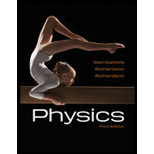
(a)
The heat flow in or out of the gas during each step.
(a)
Answer to Problem 91P
The heat flow in or out of the gas during each step are
Explanation of Solution
Write the expression for the heat for the isothermal expansion.
Here,
Write the expression for the heat for the isobaric compression.
Here,
Write the expression for the heat for the isochoric process.
Here,
Write the expression for contraction temperature.
Here,
Conclusion:
Substitute
Substitute
Substitute
Here,
Substitute
Substitute
Substitute
Therefore, the heat flow in or out of the gas during each step are
(b)
The entropy change of the gas during the isothermal step.
(b)
Answer to Problem 91P
The entropy change of the gas during the isothermal step is
Explanation of Solution
Write the expression to find the change in entropy.
Here,
Conclusion:
Substitute
Therefore, the entropy change of the gas during the isothermal step is
(c)
The entropy change of the gas for the complete cycle.
(c)
Answer to Problem 91P
The entropy change of the gas for the complete cycle is
Explanation of Solution
The entropy is a state variable, it depends on the initial and final values of the variable only. Since the process completes a cycle, the change in entropy of the gas is zero. But to validate the second law of
Therefore, the entropy change of the gas for the complete cycle is
Want to see more full solutions like this?
Chapter 15 Solutions
Physics
 College PhysicsPhysicsISBN:9781305952300Author:Raymond A. Serway, Chris VuillePublisher:Cengage Learning
College PhysicsPhysicsISBN:9781305952300Author:Raymond A. Serway, Chris VuillePublisher:Cengage Learning University Physics (14th Edition)PhysicsISBN:9780133969290Author:Hugh D. Young, Roger A. FreedmanPublisher:PEARSON
University Physics (14th Edition)PhysicsISBN:9780133969290Author:Hugh D. Young, Roger A. FreedmanPublisher:PEARSON Introduction To Quantum MechanicsPhysicsISBN:9781107189638Author:Griffiths, David J., Schroeter, Darrell F.Publisher:Cambridge University Press
Introduction To Quantum MechanicsPhysicsISBN:9781107189638Author:Griffiths, David J., Schroeter, Darrell F.Publisher:Cambridge University Press Physics for Scientists and EngineersPhysicsISBN:9781337553278Author:Raymond A. Serway, John W. JewettPublisher:Cengage Learning
Physics for Scientists and EngineersPhysicsISBN:9781337553278Author:Raymond A. Serway, John W. JewettPublisher:Cengage Learning Lecture- Tutorials for Introductory AstronomyPhysicsISBN:9780321820464Author:Edward E. Prather, Tim P. Slater, Jeff P. Adams, Gina BrissendenPublisher:Addison-Wesley
Lecture- Tutorials for Introductory AstronomyPhysicsISBN:9780321820464Author:Edward E. Prather, Tim P. Slater, Jeff P. Adams, Gina BrissendenPublisher:Addison-Wesley College Physics: A Strategic Approach (4th Editio...PhysicsISBN:9780134609034Author:Randall D. Knight (Professor Emeritus), Brian Jones, Stuart FieldPublisher:PEARSON
College Physics: A Strategic Approach (4th Editio...PhysicsISBN:9780134609034Author:Randall D. Knight (Professor Emeritus), Brian Jones, Stuart FieldPublisher:PEARSON





